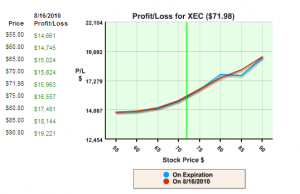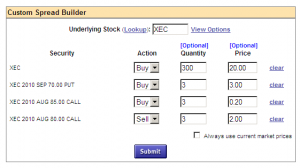Greetings, Traders!
I’ve decided that rather than bragging about MY plays, I’m going to start almost exclusively bragging about the plays of my Students.
This latest comes from Tom, who has been sitting on shares of XEC at a low cost basis for YEARS. Tom has shared the numbers with me and made them available for instructional purposes. I’m posting it here because I suspect there may be many more Traders in the same shoes as Tom: Having shares of stock that are UP… but no guarantees about the future.
This answers the problem that faces anyone that’s holding onto a stock that’s up from where they bought in. What’s a trader to do? We could sell right now because today’s price might be as high as it ever gets… or maybe we should NOT sell because after all, it’s gained so much, might it not just keep going up?
Hmmm… sell now and cap gains… hold instead and perhaps watch those gains go away…
NOT cool. Fortunately, there is a solution.
Here’s a TALL order… let’s say that Tom wants to:
- 1) Bulletproof his stock, meaning that if it goes down, his investment does NOT lose value;
- 2) continue to have an unlimited upside potential anyway;
- 3) continue taking dividends on the stock, and
- 4) turbocharge that income to receive even more than the dividend…
…can it be done? I mean, we might prevent losses by buying a protective put option. But that SPENDS money, doesn’t it? OR, we could generate some income by selling a covered call. But..! Then that would cap the potential upside. We’d be obligated to deliver the stock if it goes up.
SO, this is what Tom and I came up with. It’s pretty astounding, and covers all four of the above goals. He CAN’T lose, but CAN gain more than where he’s at now… and get paid two ways while doing it. Ready for this? Check out the following risk/reward graph:
Screen courtesy of PowerOptions Free Trial www.poweropt.com/rat
It kind of looks like long stock, doesn’t it… with no limit on the upside as the stock’s price moves. Notice anything interesting? Here’s a hint: notice the distinct lack of a break-even line. Tom’s stock is in BULLETPROOF status: He can’t possibly lose any of his investment, no matter what bad news befalls the company or the market in general.
See, the RadioActive Profit Machine setup uses an in-the-money put option. But..! Because Tom’s stock was already up from where it had started when we met… rather than coaching him that he might buy an IN-the-money put option, I pointed out that an out-of-the-money put right now could lock in a return that’s higher than his original cost, PLUS the expense of the put.
Of course, as we’ve mentioned before, Tom would like to TAKE income for holding onto XEC, not pay for the privilege. Well, I’m not finished. Look at the PowerOptions (www.poweropt.com/rat) Custom Spread entry that resulted in the above graph:
Screen courtesy of PowerOptions Free Trial www.poweropt.com/rat
WHILE paying $3 for a September $70 put option, Tom also received a $1.80 credit. See, besides picking up a long put, Tom also sold a Bear Call Spread against his stock. That credit helped pay for the put. The put is LONGER term, and the spread is SHORTER term, so he’ll have the opportunity to do this spread more than once.
Now in the case of a Bear Call Spread, the last thing you want to have happen is for the stock to go up. You might end up owing more than you collected. Hmmm… but not in THIS context, because Tom also OWNS the stock.
When you own stock and it goes up, that’s not a bad thing. This Bear Call Spread has generated income with NO risk. Should the stock stay down, Tom keeps his full credit for selling the spread. If it goes up, the increase in value of the stock will more than offset the losses of selling a bear call spread!
In “short”, Tom cannot lose with this play, where before he was at the whims of the market whether his stock would retain value or not.
Let’s fast forward a few weeks after our first coaching session:
Today Tom is closing the short $80 calls on XEC. When I got off the phone with him just now, the ask was .20 cents. He’ll leave the long $85 calls in place in case of a serious rally, and to save on commissions, but essentially he has ‘banked’ $1.60 per contract.
I’m pretty impressed with where Tom is right now: He has paid for more than half of his ‘ stock insurance policy’ (the $3 for the September $70 puts). He may now look for another spread opportunity. Because XEC has faltered a little bit, the September puts are worth more now than he paid for them, which is a bonus.
After the dust clears and (if) XEC goes up, Tom may be able to do another RadioActive Trading strategy that will not only keep his stock BULLETPROOF… but the market will also pay him to do it. I’ll keep you in the loop on that!
In the meantime, here Tom’s story so far: He has purchased September $70 put options as an insurance policy for $3 apiece. He opened Bear Call Spreads with ZERO RISK… because those spreads were done in the context of owning the stock in the first place… and has closed them so that he has banked $1.60 (at least).
Tom now is STILL holding long August $85 call options that may or may not be worth something soon… and has reduced the cost basis on his insurance policy, which is now worth more than he paid for it anyway. He has seven weeks to use one or more of the TEN RadioActive Trading Income Methods to pay for the rest of his ‘stock insurance policy’ and is a happy trader. I’ll keep you posted.
Happy Trading,
Kurt


 I'm Kurt Frankenberg, and I have discovered how to truly put the odds on the side on the individual investor.
I'm Kurt Frankenberg, and I have discovered how to truly put the odds on the side on the individual investor.
kurt, i was wondering, you said that you should never risk more than 1%of your money to any one postion, does than mean you can only take one position at a time and if not, how many postions can i take at one time without risking too much. love the blue print by the way.
This is a collar, except U have a call spread vs. just the short call.
In the opening paragraph U said U wanted to protect aginst getting the stock called away and limiting upside… so how the does having the call spread do that? Plus U have the added expense of the higher strike call as part of the spread… why is this better than a collar?
Yes, Byron! Here’s how using Inocme Method #6 protects me from getting called away at too low a strike:
Say that I want to sell a call against my married put.. which does form a collar… I am liited to the amount of premium that I receive up front for selling that call. If the stock blows past that price, why then I have OBLIGATED my self to selling at that price.
The only way I can get rid of that obligation is to buy the call back, or “buy to close”. That might happen at a premium ABOVE what I have collected. So, not cool.
OTOH, let’s suppose that I have sold a bear call spread instead. I take premium NOW… 100% of which I may keep… but because it’s in the context of actually owning the stock I have no worries at all if the stock continues up.
I’ll use an example from my OWN actual trading: I was holding a bulletproofed stock (bulletproof means that the net cost of my stock AND put option is LOWER than the strike price of the put) I saw that May $70 calls were trading at $2.76.
I might have just taken the premium from selling those calls… $2.76… and been pretty happy since I was already guaranteed not to lose any money.
However..! Instead, I sold those May $70 calls at $2.76 and simultaneously bought the May $75 calls for $1.51. Net credit was $1.25 instead of $2.76.
Why on Earth would I do that? Take only $1.25 when I could have gotten $2.76? You’ll see…
I had the idea that I wanted income on my bulletproofed stock, but that the stock MIGHT come out of its stall and head up again. It did.
AS it went up, so did the value of the long calls. The long calls that I had received at a CREDIT… remember? I owned the stock, had bulletproofed it with puts, and selling at $70 would guarantee me a profit. By selling the $70/$75 bear call spread, I ended up owning calls that I didn’t have to shell out anything for. I got a credit for doing the spread.
Fast forward a bit. The stock nears $80 a share. Had I only sold a call, I would be obligated to sell that stock for $70 plus my $2.76 credit.
Instead, this was my situation: I was indeed obligated to deliver stock at $70, but also was holding $75 calls that I had been PAID to own. Now, I sell the May $80 calls against!
Against what? Not against my stock. I already had a locked in profit there. I sold the May $80 calls against my May $75 calls. Got $2.50 credit.
What do you suppose happened next? Yup, the stock closed above $80. The $75/$80 BULL call spread that I had opened closed in the money. In the middle of the night on Expiration Saturday, my broker automatically exercised my right to buy shares of stock at $75, while automatically assigning those shares to someone else at $80.
Let’s do a review, shall we? IF I had sold a May $70 call ONLY, my total premium received would be only $2.76 and it’s goodbye, stock!
But what REALLY happened was I got $1.25 for selling a May $70/$75 bear call spread… goodbye to the stock, yes, but hello extra upside.
Added to my initial $1.25 credit was the $2.50 credit I received for selling the May $80s against my May $75s… then ANOTHER $5 credit when that bull call spread closed in the money… for a total of received premium of $8.75!
Hmmm… $2.76 versus $8.75, for deciding on the same day to take a little income. Seems like the management was worth it 😉
The end of this little story is that I made a three month, 16.22% gain on an investment that was bulletproof for most of its life, and actually had only 5.43% AT RISK at any time. That was the first day that it was open.
Hope that answers your Q, Byron! By selling a bear call spread (Income Method #6) against my stock, I was able to retain the upside potential of a moving stock, where a “plain vanilla” covered call trade couldn’t possibly perform as well.
Happy Trading!
Kurt